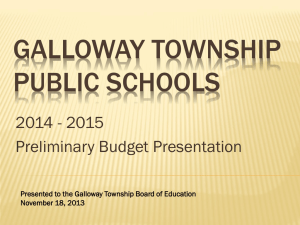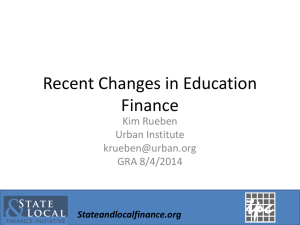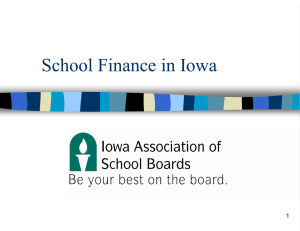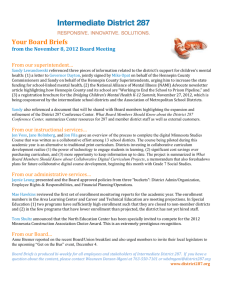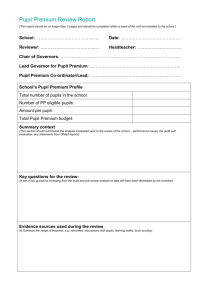School Finance Articles for Local Newspapers - IASB
advertisement
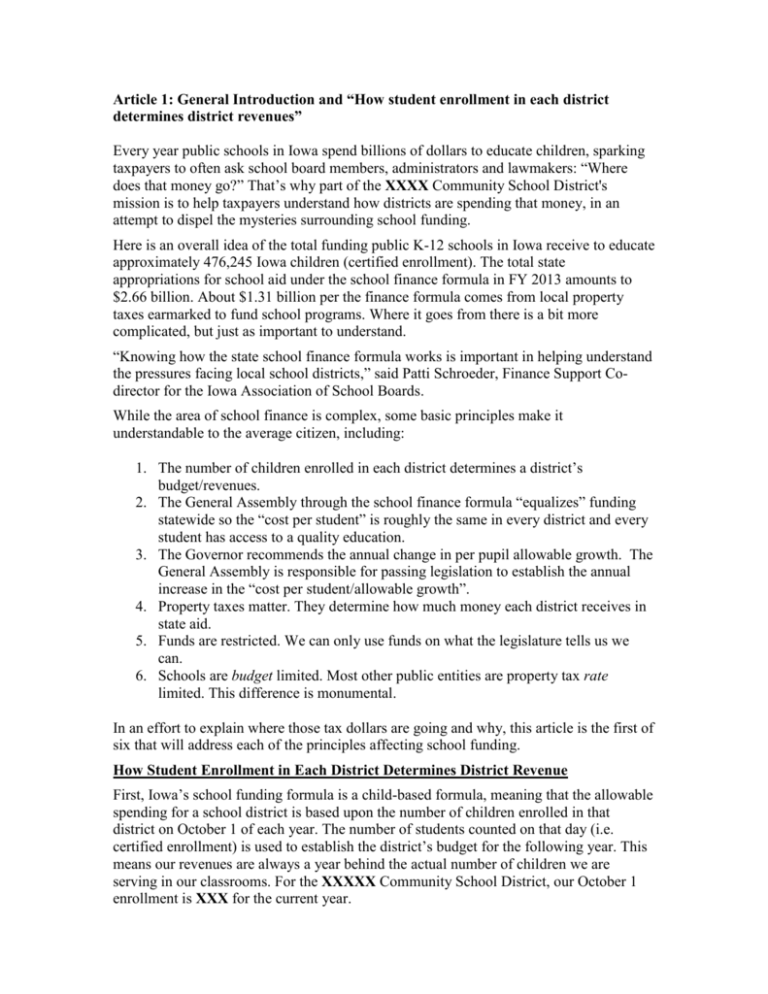
Article 1: General Introduction and “How student enrollment in each district determines district revenues” Every year public schools in Iowa spend billions of dollars to educate children, sparking taxpayers to often ask school board members, administrators and lawmakers: “Where does that money go?” That’s why part of the XXXX Community School District's mission is to help taxpayers understand how districts are spending that money, in an attempt to dispel the mysteries surrounding school funding. Here is an overall idea of the total funding public K-12 schools in Iowa receive to educate approximately 476,245 Iowa children (certified enrollment). The total state appropriations for school aid under the school finance formula in FY 2013 amounts to $2.66 billion. About $1.31 billion per the finance formula comes from local property taxes earmarked to fund school programs. Where it goes from there is a bit more complicated, but just as important to understand. “Knowing how the state school finance formula works is important in helping understand the pressures facing local school districts,” said Patti Schroeder, Finance Support Codirector for the Iowa Association of School Boards. While the area of school finance is complex, some basic principles make it understandable to the average citizen, including: 1. The number of children enrolled in each district determines a district’s budget/revenues. 2. The General Assembly through the school finance formula “equalizes” funding statewide so the “cost per student” is roughly the same in every district and every student has access to a quality education. 3. The Governor recommends the annual change in per pupil allowable growth. The General Assembly is responsible for passing legislation to establish the annual increase in the “cost per student/allowable growth”. 4. Property taxes matter. They determine how much money each district receives in state aid. 5. Funds are restricted. We can only use funds on what the legislature tells us we can. 6. Schools are budget limited. Most other public entities are property tax rate limited. This difference is monumental. In an effort to explain where those tax dollars are going and why, this article is the first of six that will address each of the principles affecting school funding. How Student Enrollment in Each District Determines District Revenue First, Iowa’s school funding formula is a child-based formula, meaning that the allowable spending for a school district is based upon the number of children enrolled in that district on October 1 of each year. The number of students counted on that day (i.e. certified enrollment) is used to establish the district’s budget for the following year. This means our revenues are always a year behind the actual number of children we are serving in our classrooms. For the XXXXX Community School District, our October 1 enrollment is XXX for the current year. “Because the school finance formula is based on the number of children enrolled in the district,” Schroeder explained, “as we gain children, we gain revenues to serve those children and, if enrollment declines, we also lose revenue.” [Superintendents: Choose the Paragraph that best describes enrollment for your district.] Paragraph for declining enrollment: Because the enrollment for our district has been declining over the past several years, this has created significant budget pressures for our district. As the district cost per child is currently $X, XXX per year, losing 10 children this year will reduce our district’s revenue by $X, XXX next year. If our district’s enrollment actually drops below the prior year our budget could be subject to a budget guarantee (101% of our prior year budget based on the school finance formula). However, our fixed costs, such as transportation, salary and benefit increases, technology and facilities, and maintenance continue to rise, despite our best efforts to economize. Paragraph for stable enrollment: Because the enrollment for our district has been relatively stable over the past several years, we’ve been fortunate that our budget has been stable or slightly increasing. However, if enrollment declines in the future we will be faced with the prospect of reduced resources to serve the needs of our district. Paragraph for increasing enrollment: Because the enrollment for our district has been increasing over the past several years, the district’s overall budget has been increasing. But remember, we are required to use last year’s enrollment in determining our budget. Each new child that moves into the district during the year is the district’s responsibility to educate, even though we don’t get any state aid or property tax for that child until the following year. This creates financial pressures in the district, as we have to hire staff and provide books, transportation and facilities for increased numbers but don’t have the resources to pay for them until the following year. Once district revenues are established, how is that money spent? It depends on state lawmakers –and this will be discussed in the second article of this series. Article 2: The General Assembly “equalizes” funding statewide so the “cost per student” is roughly the same in every district and every student has access to quality education. Taxpayers often ask, and rightfully so, how Iowa spends the over $4 billion earmarked for the state’s public education system. Last week, the (Name of Publication Here) ran the first in a series of articles dedicated to helping taxpayers understand how those dollars are being spent to educate over 476,000 students throughout the state. Today we’ll discuss how those dollars are divided. When it comes to school funding, the state legislature tries to ensure all children receive a quality education based on roughly the same amount of per pupil funding throughout the state. That’s where the school finance formula comes in. This formula relies on a combination of state aid and property taxes to fund education. The amount of state aid each district receives depends on how much it brings in through local property taxes. If the state relied solely on property taxes to fund schools, some districts would be able to raise a lot of money with a very small property tax rate (sometimes referred to as a “property rich district”), while others would raise a smaller amount of money on a much larger property tax rate (“property poor district”). This was almost exactly the situation Iowa found itself in over 40 years ago. Before the early 1970s, districts relied primarily on property taxes for school funding. However, due to the wide range of property tax rates funding districts and concern over the disparity in funding per child, lawmakers instituted a formula to address both of these issues, setting a maximum and “equal” cost per student. All districts are required to levy a Uniform Levy of $5.40 per thousand of assessed property in their district and then the state funds an additional amount up to a certain level, currently, 87.5% of the total school finance formula (called the foundation level). Beyond that foundation level, local property taxes are levied to fund the remainder of the difference. The Iowa Association of School Board’s Finance Support Co-director, Patti Schroeder, explained that school funding is basically made up of three layers. “The first layer is local property taxes determined by the Uniform Levy,” Schroeder said. “The middle layer is state aid and the top layer is additional local property taxes. The mix of all three of these is set by a formula over which the local district has little control.” The following chart provides the comparison of a district with below-average, per-pupil property tax valuation and one with an above average per-pupil property tax valuation. Our district has a (select the sentence below that applies to your district and insert it into this paragraph, beginning after the bold phrase and remove the quotation marks), Property valuation per pupil below average: "property valuation per pupil that is below the state average. This means our Uniform Levy of $5.40 generates fewer dollars and we get more state aid. However, our Additional Property Tax Levy rate is higher than the average. This is because our additional levy rate must be higher to generate the same dollars as other districts because of our lower property valuation per pupil.” Property valuation per pupil above average: "property valuation per pupil that is above the state average. This means our Uniform Levy of $5.40 generates more dollars and we get less state aid as a result. However, our Additional Property Tax Levy rate is lower than the average. This is because our additional levy rate can be lower and generate the same dollars as other districts because of our higher property valuation per pupil." Property Valuation Below Average Property Valuation Above Average Additional Levy Additional Levy State Aid State Aid Total Cost Per Pupil 87.5% of Total Cost Per Pupil Total Cost Per Pupil 87.5% of Total Cost Per Pupil $5.40 Uniform Levy $5.40 Uniform Levy While the state partially equalizes tax rates through the school finance formula, significant deviations still affect how much each district receives from the state. The lowest combined school finance formula tax rate (uniform plus Additional Levy) for a school district is $6.55 for the current fiscal year and the highest is $12.45, making that a difference of $5.90 per thousand. Regardless of the financial situation of the local school district, a large portion of the district's tax rate is set by formula and there is little the local school board members or administrators can do about it. However, Iowa law does make allowances for growth and inflation from year-to-year. We’ll discuss the concept of “allowable growth” in the third article in our series explaining school finance. * In FY 2013, Property Tax Equity Relief (PTER) bought down the highest Additional Levy rates with additional state aid. Article 3: The General Assembly controls the annual increase in the “cost per student,” called “allowable growth,” to determine how much each district receives from the state each year. Iowa law guarantees that every child in the state receives an “equal” amount of money to fund his/her education. A district’s budget is basically derived from the number of children enrolled in the district multiplied by the district’s cost per child. However, economic factors change from year-to-year, and it is up to state lawmakers to decide just how much to increase the cost per child to reflect that change. This increase is called “allowable growth,” the topic of the third article in our series on understanding school finance. Patti Schroeder, Finance Support Co-director for the Iowa Association of School Boards, explains the principle this way: “Under the basic school finance formula, each district’s spending is based upon a district cost per pupil. The total amount the district is allowed to spend is that per pupil amount times the number of students enrolled. Generally, a district can spend less than the maximum, but cannot spend more.” An allowable growth rate is recommended by the Governor and established by the Legislature. The rate is multiplied by the prior year’s state cost per pupil to calculate an allowable growth amount per pupil expressed in a dollar amount per pupil. All districts receive the same allowable growth amount per pupil. Allowable growth per pupil is intended to further provide equity in school districts throughout the state because, as we discussed last week, the legislature set a principle that each child is worth the same amount, no matter where he/she lives. Past year cost per student X Allowable Growth = Budget year cost per student Budget year cost per student X Number of students enrolled in past year = Amount district can spend in budget year The total all districts could spend for educational programs the total state appropriation was $2.66 billion in for FY 2013 and local property taxes provide about $1.31 billion, or about two-thirds state to one-third local property taxes. However, it is important to note that each district's mix of state and local property taxes is different. Why? We'll discuss this in the fourth article on how property taxes determine how much each district receives in state aid. Article 4: Property taxes matter Local property taxes account for one-third of the total funds going into districts’ programs and represent about 40% of the overall state property tax funds levied. As discussed in prior articles, the state school funding formula largely determines school property tax rates and, therefore, the amount each district receives in state aid. People often ask, "Why don't we just remove property taxes from the formula entirely?" There are several reasons why: It would take away roughly $1.31 billion dollars statewide, leaving lawmakers to decide whether to raise the state sales tax or income taxes to make up that difference. Property taxes add stability to the funding of school districts. That is, property taxes remain more stable regardless of the state of the economy. For example, if we operated solely under the sales tax, the amount available for school funding would surely fluctuate depending on consumer spending. Just as many people found out during the 1990s, too much reliance on a single funding source invites large swings in funding, which isn’t good for an entity unable to adjust to midyear revenue changes. Diversification is a prudent investing strategy that applies to schools as well. Considering the aforementioned reasons and the present revenue and political climate, removing property taxes from the school finance formula seems unlikely. No public official, whether our local school board members and administrators or the city and county officials, takes the impact of raising property taxes lightly. In most cases, public officials exhaust all other options before asking property taxpayers for more funds. However, when the General Assembly cuts short our state aid (as they have done twice in the last six years) and we experience additional, unforeseen expenses such as increased fuel and energy prices, we really have no alternative except to raise local property taxes or reduce expenditures. Seventy-five to 85 percent of school district budgets are comprised of salary and benefit costs, which doesn’t leave much discretionary spending to cut. No one likes property taxes, but they are an essential part of efficient funding of our schools. Once all 348 districts establish their budgets based on the combination of state aid and local property taxes they receive, there are still many restrictions on where and how that funding can be spent. We’ll discuss that issue in our fifth article on understanding school finances. Article 5: Funding Sources have Restrictions on Their Uses (Dillon's Rule) One of the most difficult and confusing elements of school funding is how Iowa law restricts the ways K-12 public schools can use various funding sources. Simply put, if we have a shortage in one area of the budget we cannot use other funds available to the district to offset such a shortage unless specifically allowed by law. According to the Iowa School Finance Formula, the largest funding source for schools comes from state and local property taxes. Revenues received under the formula are part of a school district's General Fund, which covers most of our expenditures for faculty and staff salaries. We also have dedicated funding streams for facilities, such as the Physical Plant and Equipment Levy, which can only be spent on buildings, grounds and certain equipment. People often refer to the General Fund side of the budget as the operations" part of the budget, while the other side is often referred to as the "bricks and mortar" side. Depending on each district’s economic and demographic situation, some face pressures from the staff side of the budget while others have more pressures on facilities. However, due to the restrictions on revenue uses, excess money from the general fund cannot be used to solve shortages on the facilities side or vice versa. As a result, we sometimes end up with districts that have adequate facilities funds but have to lay off staff. Instruction expenditures (General Fund) are equalized, but the funds we levy locally are not. The physical plant and equipment levy and debt service are valuation dependent and the revenue received varies considerably among districts. However, the statewide school infrastructure sales and service tax (better known as the state-wide penny sales tax), provides “equal” funding for school infrastructure needs and/or district property tax relief. The tax capacity of the district and the one penny revenue largely limits the amount of funds for building expenditures. The state-wide penny sales tax replaces the one-cent local option sales tax and is dedicated primarily to school buildings, equipment and property tax relief. It has proven to be a popular alternative to property taxes to renovate and build buildings. Now, with the passage of the state-wide penny for school infrastructure, by the end of FY 2014 each school district will be receiving the same amount per pupil. In short, when it comes to school spending, districts must look at all potential expenditures and determine not only if they have the money, but whether state law allows a particular fund to cover the expense. This standard, often referred to as “Dillon's Rule,” says school districts are only allowed to do what is specifically outlined by state law. This differs from cities and counties, which operate under “Home Rule,” which allows them to do anything not specifically prohibited by state law. Schools have less latitude than cities and counties in complying with the Code of Iowa, and in turn, how they spend their money. We’ll discuss more on how school and city budgets differ in our sixth and final article in this series. Article 6: Schools are Budget Limited, while other Property Tax Entities are Rate Limited K-12 public schools, cities and counties represent more than 85 percent of the total property taxes in the state of Iowa. The basic equation for property taxes in Iowa is really pretty simple; it is a tax rate multiplied by taxable value equals taxes levied. However, the way governmental entities can spend those tax dollars differs: cities and counties are "rate" limited whereas schools are "budget" limited. Rate limits carry different results from budget limits, giving cities and counties more flexibility with which to operate their budgets. For example, if a city has a tax rate of $8.10 per thousand and the property valuation in the city doubles, if they leave the tax rate unchanged, they'll have twice as many property tax dollars. Likewise, if the same city loses half of its property valuation, it will lose half of its revenue. Schools are different. The legislature effectively sets a school district's budget by setting a maximum spending per child. In a school district, if the property tax valuation doubles, the tax rate falls, but the amount of money the district has to spend is exactly the same. Likewise, if the property valuation falls by half, the total budget of the district remains the same, but the property tax rate will increase. In schools, the vast majority of the tax rate is driven by the school finance formula; local school boards have limited ability to influence the General Fund tax rate. So, how much impact can a local school board have on the district’s tax rate? The answer to this question isn’t definite; it depends. Of our total tax rate of $XX.XX per thousand, $XX.XX per thousand is due solely to the operation of the School Finance Formula, while board and voter approved levies amounting to $XX.XX supplement our instruction and provide our facility budget. While some may wish to call these “optional” levies, in reality most school districts around the state utilize some or all of these levies. Due to the low levels of spending increases in the last six years allowed by the state, there has been an increasing trend to utilize more of these “optional” levies to replace funding not provided by the state. We are committed to providing the best value for taxpayers in our district, but we are also committed to providing the best possible education in the XXXX Community School District. This is what our school board members and administrators struggle with every day. For questions or comments about any of these articles please contact Patti Schroeder, IASB Finance Support Co-director at pschroeder@ia-sb.org or (800) 795-4272, x231.

